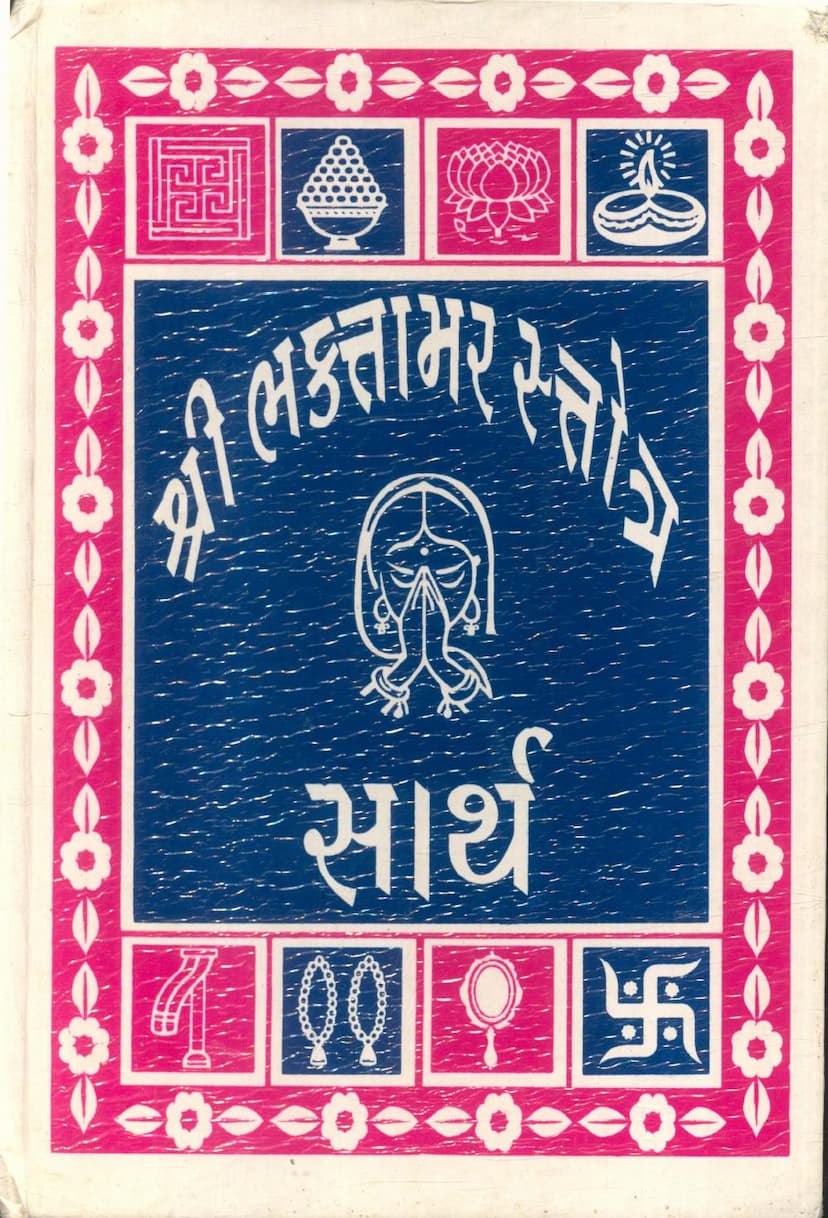Bhaktamar Stotra Sarth
Added to library: September 1, 2025

Summary
This document is a comprehensive summary and analysis of the Jain text "Bhaktamar Stotra Sarth" (meaning "Bhaktamar Stotra with Meaning"), authored by Subodhvijay and published by Mahesh Sundarlal Kapadia. The text is an explanation and compilation of the highly revered Bhaktamar Stotra, attributed to Acharya Manatunga. It also includes other important Jain texts and rituals.
Here's a breakdown of the key components and themes:
1. Introduction and Purpose:
- The book aims to provide the meaning and context for the Bhaktamar Stotra and other related stotras for the spiritual benefit of readers.
- It highlights the significance of the Bhaktamar Stotra, known for its miraculous powers and its origin story.
2. The Bhaktamar Stotra:
- Origin Story: The text recounts the famous story of Acharya Manatunga being imprisoned by King Bhoj in an iron-bound cell. The Acharya, through his intense devotion and the power of the Bhaktamar Stotra, is said to have broken the bonds and escaped, demonstrating the stotra's potency.
- Mantric Power: Each verse of the Bhaktamar Stotra is described as being imbued with mantra-like power, capable of removing obstacles, granting desires, and bestowing spiritual and material benefits.
- Structure and Content: The Bhaktamar Stotra consists of 44 verses, each praising a specific quality or attribute of Bhagwan Parshvanath, the 23rd Tirthankar. The verses are rich in imagery and devotion, describing the Tirthankar's divine form, powers, and compassion.
- Applications: The text details how chanting specific verses or the entire stotra can help overcome various challenges like illness, fear, poverty, enmity, and negative influences. It also provides guidance on specific rituals and mantras associated with the stotra for achieving particular results.
3. Other Included Texts and Rituals:
- Rushimandal Stotra (Small and Large): This stotra is presented alongside the Bhaktamar Stotra, emphasizing the group of "Rishis" (often interpreted as Tirthankaras or spiritual masters) and their collective spiritual power. The text delves into the meaning, significance, and correct methodology for reciting the Rushimandal Stotra and its associated yantras (mystical diagrams).
- Phulgunthani (Flower Garland): A unique aspect is the "Phulgunthani," a combination or synthesis of the Kalyana Mandir Stotra and the Bhaktamar Stotra. This is presented as a practice that helps alleviate mental agitation and distress.
- Guru Stotras and Prayers: The book begins with prayers and salutations to gurus and deities, including Guru Bandana, Trisashthishilaka Purusha Prabhatiya (morning prayer for the 63 great souls), and the Navkar mantra.
- Daily Observances: "Diva Ratrina Pachchakhan" (daily vows and renunciations) are included, outlining Jain practices for controlling senses and actions.
- Maha Pujan: The text describes the ritual of "Bhaktamar Maha Pujan" (Great Worship of Bhaktamar), outlining the steps and mantras involved.
- Mantras and Yantras: Detailed mantras and yantras are provided for various deities, celestial bodies (Navagraha - nine planets), and specific rituals, often linked to healing and protection.
- Biographies: Brief biographies of the revered Acharyas and Munis associated with the creation and dissemination of these texts are included, such as Acharya Vijay Bhanuchandrasurishwarji and Panyas Shri Subodhvijayji. This adds a personal and historical dimension to the spiritual content.
- Dedication: The book is dedicated to the parents of the publisher, Mahesh Sundarlal Kapadia, indicating a deep sense of respect and gratitude.
4. Philosophical and Practical Aspects:
- Karma and Destiny: The text implicitly acknowledges the Jain philosophy of karma, explaining how present circumstances are influenced by past actions and how devotion and virtuous deeds can alter one's destiny.
- Devotion and Faith: The emphasis throughout the text is on unwavering faith, sincere devotion, and meticulous adherence to rituals for spiritual and material well-being.
- Achieving Siddhis: The book suggests that by performing the prescribed rituals and mantras with the right intention and purity, practitioners can attain various "siddhis" (spiritual powers or accomplishments), blessings, and ultimately liberation.
- Ethical Conduct: While focusing on devotional practices, the underlying message promotes righteous living, compassion, and adherence to Jain principles.
5. Detailed Explanations and Case Studies:
- Each verse of the Bhaktamar Stotra is often accompanied by a short narrative or example (katha) illustrating its specific efficacy in resolving problems, healing diseases, or bestowing blessings. These stories serve to reinforce the stotra's power and inspire faith in the reader.
- The text provides detailed instructions for the proper recitation, purification of the space, and invocation of deities or spirits associated with the mantras.
In essence, "Bhaktamar Stotra Sarth" is a devotional guide that aims to empower Jain followers by providing them with the spiritual tools, knowledge, and practical guidance to harness the immense power of the Bhaktamar Stotra and related Jain practices for personal well-being, spiritual growth, and the attainment of liberation. The inclusion of other stotras and rituals broadens its scope, making it a comprehensive resource for spiritual aspirants.